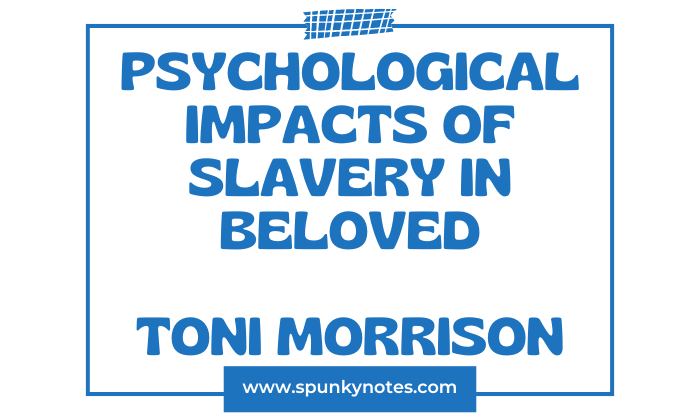
Q. How does Morrison portray the physical and psychological impacts of slavery on the characters in Beloved?
Q. Discuss the significance of the setting post-Civil War America. How does history shape the characters’ lives?
Psychological Impacts of Slavery in Beloved
Significance of Post-Civil American War
The setting of post-Civil War America is crucial in Morrison’s Beloved. This period was a time of significant change and uncertainty. For formerly enslaved people and their descendants, freedom was a new and challenging concept.
Although legally free, many continued to face intense discrimination and limited opportunities socially and economically. This historical context profoundly shapes the characters’ lives, influencing their decisions, opportunities, and identities.
The setting of “Beloved” after the Civil War is crucial as it dramatically shapes the characters’ lives. This period was filled with challenges for African Americans seeking their place in a society that was hesitant to accept them as equals.
1- Economic and Social Impact
Characters like Sethe and Paul D struggle to build stable lives because society still treats them with suspicion and discrimination. They face challenges in finding jobs and maintaining their dignity, reflecting daily broader difficulties.
2- Identity and Belonging
In “Beloved,” the struggle for identity and belonging is central. The characters, having been deprived of their cultural heritage and histories during slavery, work to create new identities for themselves. The support from their community is crucial in this effort, helping them to heal from their traumas and imagine a better future.
3- Memory and History
Shared memories and stories help the characters process their past traumas. These elements are key to developing a new sense of self and community among the formerly enslaved.
4- Psychological and Physical Impact of Slavery
Toni Morrison’s Beloved clearly shows the deep psychological and physical scars that slavery leaves on characters. The experiences of slavery affect not only the physical health of characters but also profoundly impact their mental state and emotional well-being.
Characters often show signs of trauma, including nightmares, fear, and an ongoing sense of loss. This trauma affects how they interact with others and how they see themselves, often causing difficulties in forming trusting relationships or maintaining a stable sense of self.
Physically, the harsh realities of slavery are evident in Morrison’s characters, who may bear scars or have endured brutal physical treatment.
These experiences are not just memories; they continue to influence the characters’ lives in the present. The physical toll is coupled with emotional pain as characters suffer from the memories of abuse and degradation.
1- Sethe
Physical Effects: Sethe, the protagonist of Toni Morrison’s “Beloved,” carries deep physical marks from her time as an enslaved person. The most significant and symbolic of these is the network of scars on her back, which she describes as a “chokecherry tree.”
These scars are the result of brutal whippings she endured, serving as a constant, painful reminder of her past. Such physical abuse not only scarred her skin but also left lasting damage that affected her physical movements and comfort.
Psychological Effects: The psychological effects of slavery on Sethe are profound and pervasive. Haunted by the trauma of her past, Sethe lives in a state of constant alertness and deep fear that her former enslavers might come to reclaim her and her children.
This fear drives her to make a desperate decision to kill her daughter, Beloved, to spare her the horrors of slavery—a choice that leaves her with a burden of guilt and grief.
Sethe’s mental state is further complicated by the arrival of Beloved’s ghost, who returns not only as a spectral presence but also as a reincarnation of her daughter in physical form.
This haunting is both literal and metaphorical, representing the way past traumas continue to intrude on the present. Sethe’s interactions with Beloved force her to confront her past, leading to moments of intense psychological turmoil as she relives her traumatic memories.
2- Paul D
Physical Effects: Paul D, a character in Toni Morrison’s “Beloved,” bears the physical scars of slavery much like Sethe, though he is less visible.
His most harrowing physical experience of slavery includes the forced wearing of an iron bit in his mouth, a cruel device used to silence and dehumanize him.
This degrading treatment is symbolic of the physical control and abuse inflicted upon enslaved people. Paul D also endured the brutality of labour in a chain gang, which left him with long-lasting physical ailments and pains that he carries into his life post-slavery.
Psychological Effects: The psychological effects of slavery on Paul D are deep and enduring. His experiences have instilled in him a profound sense of confinement and emasculation, which manifest in his often guarded and volatile emotional expressions.
Paul D struggles with feelings of unworthiness and a deep-seated fear of forming attachments. His memories of the past are like a “tin tobacco box” locked in his chest, where he compartmentalizes his traumatic memories to cope with everyday life.
Paul D’s emotional journey throughout “Beloved” shows his struggle with vulnerability. He fears intimacy because of the powerlessness he experienced as a slave, making it difficult for him to maintain close relationships.
His journey to reconnect with Sethe and her family is fraught with emotional upheaval as he confronts Beloved’s ghost, forcing him to face the painful memories he has long suppressed.
3- Baby Suggs
Baby Suggs, a character in Toni Morrison’s “Beloved,” experiences severe physical and psychological effects from her years in slavery. Physically, years of forced labour have left her body worn and weak. After gaining her freedom, her health continues to decline, showing how deeply slavery impacted her physically.
Psychologically, Baby Suggs is deeply scarred by the loss of her children, who were taken away from her and sold. This loss fills her with enduring sadness. Despite her freedom, she carries the weight of her past, which affects her emotional well-being.
In her later years, Baby Suggs becomes a spiritual leader in her community. She uses her home as a space to heal and support others who have suffered similar traumas. She encourages people to appreciate and care for themselves in ways they are free people.
However, the brutal act of Sethe, her daughter-in-law, who kills her child to prevent her from being enslaved, profoundly affects Baby Suggs. This event leads her to withdraw from her community work, spending her last days in reflection and isolation.
Conclusion
“Beloved” by Toni Morrison vividly portrays the lasting effects of slavery on individuals such as Sethe and Paul D. The novel not only shows their physical but also psychological scars.
The story addresses their struggles in seeking identity and belonging in a society that is slow to change. Morrison’s narrative goes beyond individual stories to depict the collective endeavour of overcoming a traumatic history.

